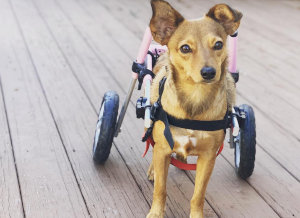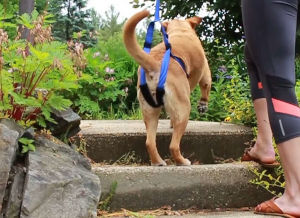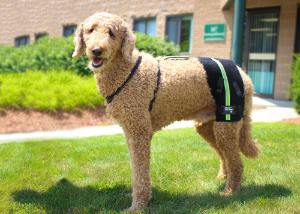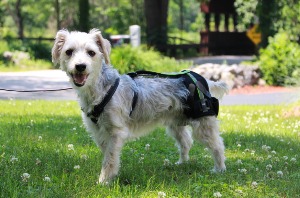Does My Dog Have Hip Dysplasia?
By admin / January 17, 2023 / No Comments / Uncategorized
Article written by Dr. Lucy Tidd, DVM
What is Hip Dysplasia?
Hip dysplasia is a fairly common issue for dogs, especially for larger or more muscular breeds such as German Shepherds, Saint Bernards, Labrador Retrievers, Golden Retrievers, Old English Sheepdogs, and Bulldogs. The problem begins during puppyhood, when the thighbone and the hip socket do not grow at equal rates, causing looseness in the joint and leading to degenerative joints or osteoarthritis.
While hip dysplasia is a genetic disease, several factors can impact its severity, such as:

- Diet
- Environment
- Exercise
- Growth rate
- Muscle mass
- Hormones
Some dogs show symptoms of hip dysplasia early in their life, while others may not exhibit any signs of the disease, despite having X-rays proving its presence. It’s very important for dogs to be fed a healthy diet and get plenty of exercise throughout their life to reduce the problematic effects of hip dysplasia.
Signs My Dog Has Hip Dysplasia
Since hip dysplasia is quite common, it’s crucial that you can recognize the signs early on in order to provide the best interventions and pain management for your dog.
Some common signs that your dog may be developing canine hip dysplasia include:
1. Decreased Activity
If your dog has become noticeably less active, spends more time resting, or shows little enthusiasm for regular walks and activities, it could be their way of managing pain. While many people attribute their dog’s sedentary nature to aging, it’s possible they are suffering from canine hip dysplasia.
2. Inability to Jump or Climb Stairs

Your dog’s hind legs play an important role in their ability to climb stairs and jump.
When hip dysplasia occurs, inflammation develops, causing your dog to suffer from a smaller range of motion than it would otherwise have. In addition, inflammation and hip pain can make using the stairs challenging for a dog with hip dysplasia.
3. Difficulty Standing Up
If you notice that your dog is slower to rise than usual, having great difficulty standing up from a lying position, it could be due to pain. Providing a comfortable bed or carpeted area for your dog to rest on will make rising a little easier and decrease pain more so than harder floors such as tile, linoleum, or wood.
4. Changes in Gait
This is sometimes called “bunny-hopping” and refers to abnormal changes in how your dog walks. It’s called this because dogs will lift both hind legs at once, as though jumping like a rabbit. This is thought to decrease the pain they feel in their hind legs and the amount of weight bearing down on them.
5. Limb Numbness
If your dog’s hip dysplasia is severe, you may observe lameness in the hind legs. This could be intermittent or continuous as the wear and tear on your dog’s hip joints increases. The resulting inflammation and pain can cause your dog to be unable to walk on their hind legs at all.
6. Hip Pain and Sensitivity

If your dog shows signs of discomfort when you touch its hips, it could be associated with hip dysplasia. As the shock-absorbing cartilage surrounding the hip joint and socket wears down, the skin around the area grows tender to the touch.
A dog hip brace helps to relieve canine hip pain and encourage mobility. While these are some common symptoms of hip dysplasia, an X-ray from your veterinary technician can determine the true cause. The disease is clearly visible on X-rays, as you can see how the thighbone and hip socket deteriorate over time.
What to Do for a Dog Showing Signs of Hip Dysplasia?
When caring for your furry best friend, it’s never too early to take action to prevent painful hip dysplasia. There are four important steps you can take to decrease your canine’s chances of suffering from this debilitating disease:

- Avoid overfeeding your dog: Extra weight will put added pressure on the hips and joints, so overfeeding is a bad idea.
- Don’t overdo it with exercise: While exercise is great for a growing dog, steering clear of too much activity will reduce the chances of dysplasia setting in. Furthermore, don’t let your pup play on slippery surfaces or jump from excessive heights, as this could cause permanent damage to the hips.
- Check your pup’s pedigree: When it comes to pedigree, some dog breeders are more interested in turning a profit than doing their part to enhance a dog’s bloodline – don’t be afraid to ask for references.
- Give your dog hip and joint supplements: There are several high-quality supplements that will serve to reduce your dog’s risk of developing hip dysplasia, the most common ingredients being glucosamine and chondroitin. These will promote healthy joints in your pup and lessen the chances of them developing canine hip dysplasia.
If your dog is in the higher-risk category of canine breeds, it’s critical that you implement preventative care from a young age. Protecting your dog from hip dysplasia is a big responsibility, but the payoff is a happy and healthy pup that grows and thrives along with you.
Can You Prevent Hip Dysplasia in Dogs?
While it is sometimes difficult to assess whether your dog is genetically more likely to develop hip dysplasia, there are some ways in which you can reduce the risks. Hip dysplasia is a painful and debilitating disease, so it’s important to be proactive from the start to ensure your pup lives a long and healthy life. A high-quality diet, joint health supplements, and maintaining a healthy weight have proven to have the most significant impact on preventing hip dysplasia.
Dogs with hip dysplasia can be treated through surgical care to repair or replace joint misalignment, but this is often used as a last resort, as it can be expensive and requires a long recovery period. While hip dysplasia is caused by a combination of genetic and environmental factors, it’s your job to ensure the best life possible for your furry best friend.


Guest Author:
Dr. Lucy Tidd, DVM
Dr. Tidd is a veterinarian at Germantown Veterinary Clinic in Germantown, MD.
Dr. Tidd is a graduate of Cornell University (BS Animal Science) and Cornell College of Veterinary Medicine. She currently sits on the Alumni Board for the latter institution. Dr. Tidd has a special interest in internal medicine, and she enjoys challenging medical and surgical cases.
